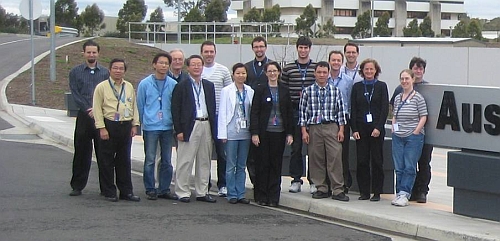Headed by Anita Hill and Manh Hoang, the MEWE group is developing new-generation materials that could one day play a part in overcoming the big challenges faced by Australia in energy, water and the environment.
MEWE team members have pooled their resources to take on a broad range of synchrotron experiments.
“Working as a big team allows us to use discoveries made about our materials on one beamline to enhance experiments done subsequently on others,” Anita says. “Combining this powerful approach with the powerful analytical tools available at the Australian Synchrotron brings the next big breakthroughs that much closer.”

MEWE team members outside the Australian Synchrotron.
Thermally-rearranged polymer membranes
For example, one project undertaken by Anita and her colleagues involves using the small angle x-ray scattering (SAXS) beamline to examine the development of tailored porosity in thermally rearranged (TR) polymer membranes. MEWE reported these membranes in Science for their outstanding gas separation properties and thermal stability. The group has commissioned a Linkam furnace to use on the beamline with a heating stage specifically designed for in-situ characterisation. The cell enables ultra-precise temperature control (down to 0.1°C) and a customised atmosphere, so that the exact conditions required to deliver the exceptional separation performance can be precisely replicated.
This work is part of an international collaboration between CSIRO, Hanyang University, University of Texas at Austin, and Virginia Tech. Young Moo Lee and Sang Hoon Han from Hanyang University came to the Australian Synchrotron for the experiments.
Metal organic frameworks
Matthew Hill, Danielle Kennedy and Emily Mensforth are using the powder diffraction and crystallography beamlines to determine the structure of a new class of materials known as metal organic frameworks, or MOFs. These highly porous materials have application in areas such as renewable energy and medicine. Prospective materials are examined using powder diffraction, with a special high-throughput setup that can run hundreds of samples a day. Then the exact structure of the best materials is determined using the crystallography beamline. Materials developed by MEWE currently hold the records for room temperature methane and hydrogen storage, and may find application in alternative car fuel systems.
Paolo Falcaro and Dario Buso have been using the capabilities of the infra-red, powder diffraction and SAXS beamlines to study a variety of new materials. Inspired by their sol-gel background, they have been exploring new methods for using customised nucleating agents to scale-up production of MOFs. Proposed solutions range from the use of nanoparticles with controlled surface chemistry to the development of microspheres of oxides/hydroxides. The synchrotron beamlines have been essential to unveil the inner nature of these new species.
Light metal alloys
In collaboration with the University of Queensland, Matthew Lay and Tim Bastow are using x-ray absorption to study the clustering and ordering of solute atoms in light metal alloys. Light metal alloys are widely used for their low weight and high strength, but subtle changes in their nanostructure can degrade these properties. The synchrotron experiments serve as a strong backbone to careful lab-scale experiments already underway.
Gelling agents in foods
Kate Nairn and James Mardel are working with scientists from CSIRO’s Food Futures Flagship to better understand gelling agents used to thicken and stabilise foods. Gelling agents also improve the texture of reduced fat foods. How the molecules are arranged within the gels is crucial to the rheology of the final food – but not well understood. MEWE is employing SAXS to investigate the structure of these gels, with a view to eventually creating healthier, tastier foods.
Inorganic phosphates for biomedical implants
Harry Whitfield is an expert in developing new inorganic phosphates – materials that are crucial for biomedical implants. These materials are notoriously difficult to make well, and their structure can be even harder to nail down. Working with CSIRO and synchrotron staff, Harry combined the strengths of the powder diffraction and crystallography beamlines to identify new forms of these materials, and identify the precise location of all atoms in the structure from a crystal just a few micrometres in size. Harry hopes these newly-discovered structures will lead to new properties that could find widespread application.
Hybrid organic-inorganic membranes for water purification
Zongli Xie and Tuan Duong are using the infra-red beamline to study the crosslinking of hybrid organic-inorganic membranes based on PVA and silica and used for water purification. The improved spatial resolution achieved by using a synchrotron light source should provide clearer insights into crosslinking in the membranes. Such information is critical for understanding the structure-performance relationship of the hybrid membranes. The work is part of a research project led by Manh under CSIRO’s Water for a Healthy Country Flagship program.
